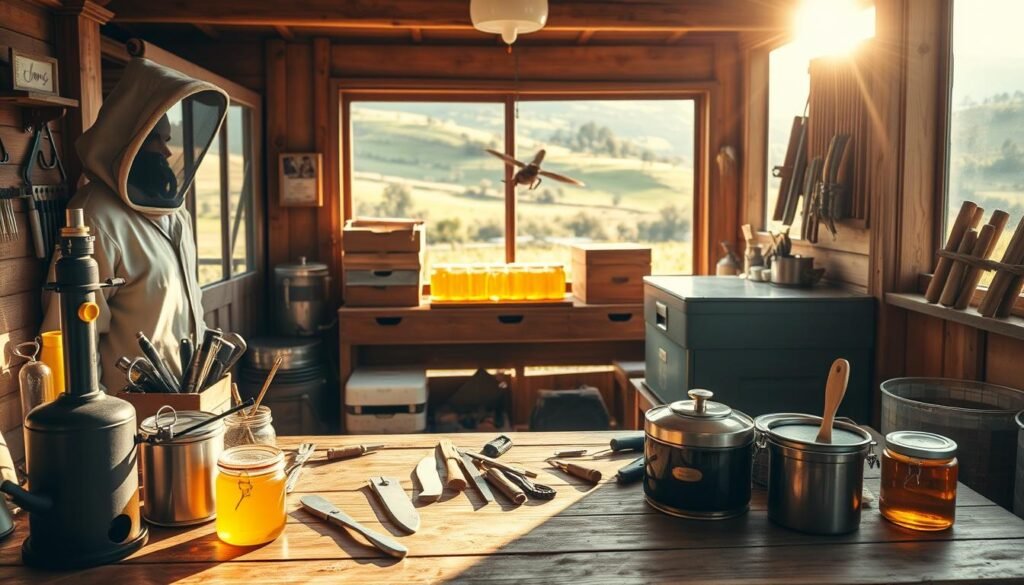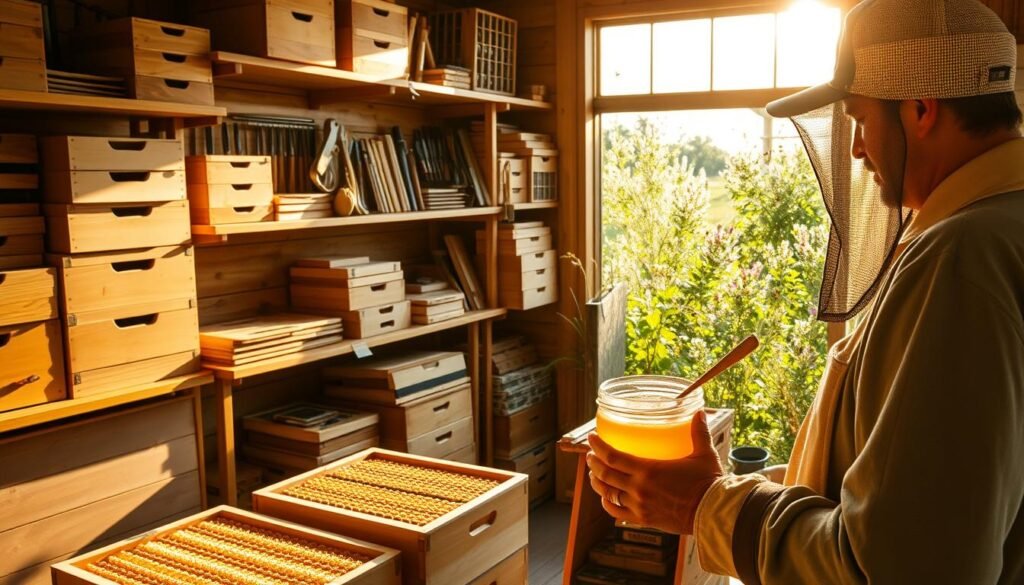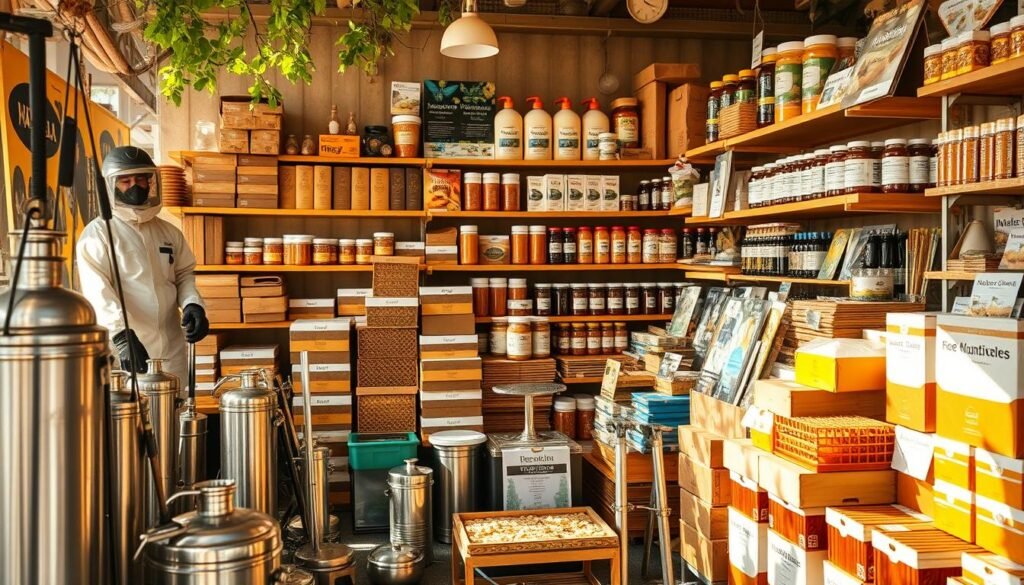For those passionate about nurturing hives across Australia’s vast landscapes, finding durable tools built for local conditions matters. Our online store serves as the premier destination for apiarists seeking reliable gear that stands up to scorching summers, tropical humidity, and everything in between.
We stock an extensive selection of professionally tested equipment, from protective suits to honey extraction systems. Every product undergoes rigorous quality checks to ensure it meets the demands of commercial operations and backyard enthusiasts alike. Climate resilience sits at the heart of our curation process.
Beyond hardware, we prioritise guidance for customers navigating their beekeeping journey. Our team offers personalised advice on selecting gear tailored to specific regional challenges. Whether managing hives in Queensland’s rainforests or Western Australia’s arid zones, we’ve got you covered.
Competitive pricing and nationwide delivery make premium tools accessible without compromising on durability. We’re committed to supporting Australia’s thriving apiarist community through education, responsive service, and equipment designed to last.
Key Takeaways
- Australia’s top source for professional apiarist gear
- Products rigorously tested for diverse climate conditions
- Expert guidance for regional beekeeping challenges
- Competitive pricing with reliable nationwide delivery
- Dedicated to community education and support
Introduction to Australian Beekeeping
Australia’s unique ecosystems create ideal conditions for thriving honeybee populations. With over 25,000 registered apiaries, the industry supports both boutique honey producers and agricultural pollination services nationwide.
Diverse Environments, Varied Practices
From Tasmania’s cool climate to Queensland’s subtropical zones, beekeeping methods adapt to local flora. Eucalyptus forests dominate honey production, while almond orchards rely on migratory hives for pollination. Small urban apiaries coexist with commercial operations managing thousands of colonies.
Seasonal shifts dictate beekeepers’ calendars. Spring triggers swarming in northern regions, while southern keepers focus on winter hive insulation. “Our seasons flip traditional beekeeping wisdom,” notes a third-generation apiarist from Victoria.
Guardians of Ecosystems
Modern Australian beekeepers balance honey harvesting with ecological stewardship. Key responsibilities include:
- Monitoring hive health to prevent varroa mite outbreaks
- Maintaining native vegetation around apiaries
- Following strict biosecurity protocols during honey extraction
Their work sustains food systems – approximately 65% of Australian crops benefit from bee pollination. Recent regulations require all keepers to register hives, ensuring traceability during disease outbreaks.
The Importance of Quality Equipment in Beekeeping
Superior apiarist equipment forms the backbone of successful hive management across Australia’s challenging environments. Durable tools withstand harsh UV exposure and temperature extremes while maintaining precise functionality during inspections.
Safety First: Protective Gear and Tools
Full-body suits with reinforced stitching create the first line of defence against stings. Ventilated gloves allow dexterity during frame handling, while wide-brimmed veils provide clear visibility. Properly sealed boots prevent curious bees from crawling up trouser legs.
Regular gear inspections prevent wear-related accidents. “A single tear in your veil can turn routine maintenance into an emergency,” warns a NSW apiarist trainer. Stainless steel smokers and hive tools resist corrosion from propolis buildup.
Enhancing Hive Productivity
Well-designed hive bodies promote optimal brood patterns and honey storage. Standardised frame dimensions allow easy colony expansion during nectar flows. Extractors with adjustable speed settings preserve comb integrity for multiple harvests.
| Features | Quality Equipment | Budget Alternatives |
|---|---|---|
| Material Durability | UV-stable polymers | Thin plastics |
| Safety Assurance | Double-stitched seams | Single stitching |
| Replacement Cycle | 5-7 years | 12-18 months |
| Hive Disturbance | Minimal during checks | Increased stress |
Investing in professional-grade equipment reduces long-term costs through extended lifespans. Properly maintained tools also minimise colony disruption, supporting healthier honey production cycles.
Best “beekeeper supplies” for a Successful Apiary
Building a thriving apiary starts with selecting the right foundational tools. Essential hive components form the structural backbone, including durable bottom boards and deep brood chambers. These elements protect colonies from predators while allowing proper airflow – critical in Australia’s fluctuating temperatures.
Consumable products demand regular attention. Foundation sheets guide comb construction, while frame wires reinforce heavy honey stores. Lubricants keep hive tools rust-free, especially in coastal regions where salt air accelerates wear. “Replace these items before they fail – prevention beats emergency repairs,” advises a Queensland apiculture specialist.
Seasonal adjustments prove vital for hive health. Winter requires insulated feeders to sustain colonies during dearth periods. Summer calls for ventilated inner covers that reduce heat stress without compromising security. Northern beekeepers often add ant-proof moats, while southerners prioritise moisture control.
Specialised gear varies by operation type. Honey producers select premium-grade extractors, while pollination-focused keepers invest in transport-friendly hive wraps. Queen breeders need precise grafting tools and cell-building frames. Always check for UV-resistant materials and stainless steel fittings when choosing beekeeping supplies.
Quality indicators separate lasting investments from short-term solutions. Look for:
- Interlocking joints in woodenware that prevent warping
- Double-stitched seams on protective gear
- Certified food-grade plastics in honey harvesting equipment
These features ensure your bee supplies withstand decades of Australian conditions while maintaining colony productivity.
Extensive Product Range for Every Beekeeper
Australia’s diverse apiculture practices demand equipment that adapts to varied operational scales and climates. Our inventory caters to urban hobbyists managing two hives and commercial operators overseeing thousands, with solutions designed for seamless integration into existing workflows.
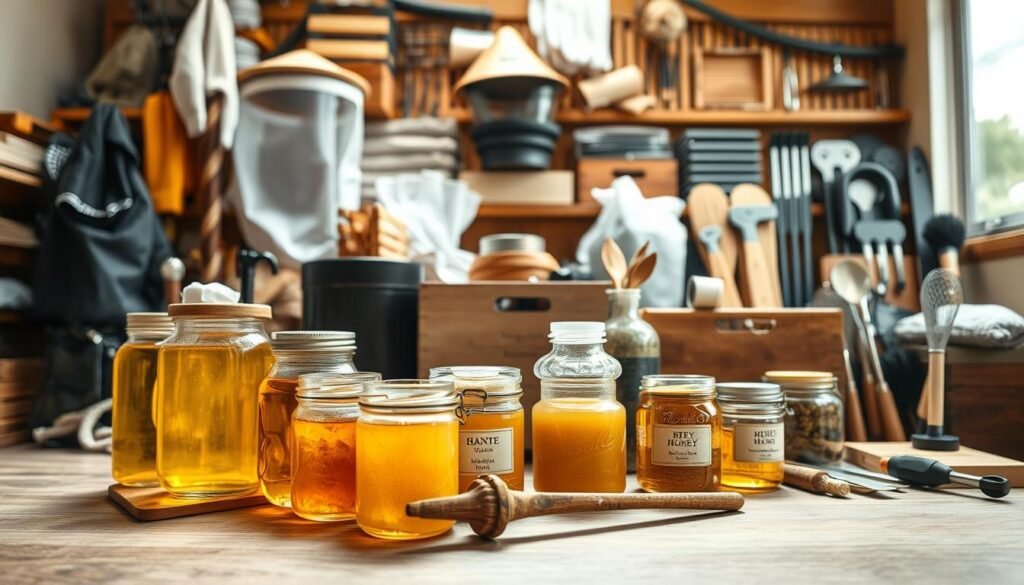
Beehives, Hive Kits and Frames
Choose from complete hive kits that simplify colony establishment, including popular Langstroth models and space-efficient top-bar designs. Nucleus hives offer compact solutions for urban spaces or apiary expansion. Each kit features:
- Interlocking joints preventing warping in humid zones
- Triple-coated Australian hardwood resistant to termites
- Customisable entrance reducers for pest control
Our frame selection addresses specific colony needs, with deep brood frames supporting population growth and medium honey supers optimising nectar storage. Foundation options range from wax-coated sheets for natural comb building to durable plastic alternatives.
Honey Harvesting and Processing Equipment
Efficiency meets precision in our harvesting systems. Manual extractors suit small-scale operations, while radial electric models handle 45 frames per cycle. “Proper filtration maintains honey’s natural enzymes,” notes our lead product tester, highlighting the importance of stainless steel mesh filters in preserving quality.
The processing range includes:
- Temperature-controlled uncapping knives preventing wax scorching
- Food-grade bottling tanks with honey gates for mess-free filling
- Commercial-grade decrystallisers maintaining product viscosity
From backyard enthusiasts to licensed processors, every tool undergoes rigorous testing for compliance with Australian food safety standards. Custom configurations accommodate unique workflow requirements, ensuring seamless scaling as operations grow.
Innovative Solutions for Hive Management
Modern apiarists are embracing smart technologies that transform how colonies thrive in Australia’s demanding climates. Advanced monitoring systems now work alongside traditional methods, creating efficient hive management strategies that protect bee health while boosting productivity.
Frame Foundations and Hive Bodies
Choosing the right frames foundation impacts colony development and honey yield. Plastic foundations offer durability for commercial operations, while natural beeswax sheets suit organic practices. Wax-coated options strike a balance, resisting heat distortion in northern regions.
| Foundation Type | Key Benefits | Best For |
|---|---|---|
| Plastic | Reusable, minimal maintenance | High-volume operations |
| Beeswax | Natural comb building | Boutique honey producers |
| Wax-Coated | Heat resistance + easy extraction | Subtropical zones |
Modern hive bodies use composite materials that outlast traditional timber. These UV-stable designs prevent warping in humid coastal areas. Ventilation slots regulate internal temperatures, reducing stress during heatwaves.
Digital sensors track colony activity without disturbing bee clusters.
“Real-time data helps prevent swarming and detects mite infestations early,”
explains a Victorian apiarist using smart hive systems. Integrated pest traps attach directly to hive entrances, capturing threats before they spread.
These innovations support sustainable practices through precision management. Reduced hive inspections mean colonies maintain natural rhythms, while durable materials cut replacement costs by 40% compared to conventional setups.
Customer-Focused Online Shopping Experience
Navigating the digital marketplace for apiculture tools requires platforms that understand regional needs. Our online portal combines local expertise with intuitive design, helping apiarists source equipment quickly between hive inspections.
The platform’s customer-focused design features filtered searches by climate zone and operation size. High-resolution images with 360-degree product views let you inspect gear details before purchasing. Detailed specifications include UV resistance ratings and compatibility with Australian hive standards.
Secure payment gateways process transactions with bank-grade encryption. Multiple options cater to different preferences:
| Features | Our Platform | Typical Platforms |
|---|---|---|
| Navigation | Climate-zone filters | Basic categories |
| Checkout Speed | 90-second average | 3+ minutes |
| Support Options | Live chat + SMS | Email only |
| Delivery Times | 2-5 business days | 7-10 days |
Real-time tracking updates follow every order from warehouse to property gate. Our dedicated support team assists with urgent requests – like replacing split supers during peak season. Commercial operations benefit from scheduled bulk deliveries that sync with pollination contracts.
This customer-centric approach ensures you shop with confidence, backed by a comprehensive service network spanning all states and territories.
Beekeeping Supplies for All Levels of Experience
Mastering apiculture requires equipment that matches your growing skills. Whether nurturing your first colony or managing commercial operations, the right tools determine success. Our range evolves with your expertise, offering solutions from basic setups to specialised systems.
Starter Kits for Beginners
New enthusiasts receive complete kits containing hive bodies, smokers, and veils with clear instructions. These packages simplify initial setup while teaching core techniques. Essential components include:
- Pre-assembled Langstroth hive with entrance reducers
- Ergonomic hive tool with safety grip
- Ventilated suit featuring colour-coded zippers
“Our beginner sets eliminate guesswork,” explains a Melbourne apiculture mentor. Video tutorials accompany each kit, demonstrating seasonal inspections and swarm prevention.
Advanced Tools for Seasoned Professionals
Commercial operators access industrial-grade extractors and modular hive systems. Queen-rearing kits enable precise grafting, while thermal imaging cameras monitor brood patterns. Features prioritising efficiency dominate this tier:
| Feature | Starter Kits | Advanced Systems |
|---|---|---|
| Materials | Pine timber | Marine-grade polymers |
| Automation | Manual tools | Remote sensors |
| Scale Capacity | 1-5 hives | 50+ colonies |
| Support | Email guides | Dedicated hotline |
Scalable solutions allow gradual upgrades as skills develop. Workshops and webinars complement equipment purchases, bridging knowledge gaps at every stage. This approach ensures lasting value, whether maintaining backyard hives or supplying pollination services nationwide.
Comprehensive Apiary Equipment and Tools
Precision tools separate efficient apiaries from struggling operations. Every task demands reliable instruments that match Australia’s rugged conditions while protecting colony health. From routine inspections to honey harvesting, the right gear ensures smooth workflows and minimal hive disruption.
Essential Hive Tools and Smokers
Stainless steel hive tools serve as multi-purpose workhorses. Their curved edges pry apart propolis-sealed boxes, while sharp ends scrape excess wax. Look for heat-treated models that resist bending during heavy use. “A quality tool feels like an extension of your hand,” remarks a Queensland pollination specialist.
Smokers calm colonies using cool, consistent smoke. Modern designs feature:
| Feature | Traditional Copper | Stainless Steel |
|---|---|---|
| Fuel Capacity | 30 minutes | 45+ minutes |
| Heat Resistance | Moderate | Extreme |
| Maintenance | Weekly cleaning | Bi-monthly |
| Lifespan | 3-5 years | 7-10 years |
Specialised accessories boost efficiency. Frame grips prevent drops during inspections, while uncapping forks prepare combs for extraction. Bee brushes with ultra-soft bristles gently relocate workers without harming wings.
Regular maintenance extends equipment lifespans. Clean tools with food-safe sterilants after each use. Store smokers upside-down to prevent ash buildup. Replace worn gaskets promptly to maintain airflow control.
Ergonomic designs reduce strain during long workdays. Rubberised handles improve grip in humid conditions, while lightweight aluminium tools minimise arm fatigue. These features prove vital for commercial operators managing hundreds of hives.
Enhancing Beekeeping with Quality Protective Gear
Proper protection transforms hive interactions from stressful to productive. Dancing Bee Equipment’s protective gear combines advanced materials with ergonomic designs, prioritising safety without sacrificing comfort. Whether inspecting urban hives or managing commercial apiaries, the right ensemble adapts to Australia’s unique challenges.
Selecting equipment requires evaluating three factors: sting sensitivity, colony temperament, and task duration. Lightweight jacket-and-veil combinations suit quick inspections, while full-body suits with elastic cuffs provide complete coverage for aggressive hives. Ventilated options feature mesh panels that reduce heat stress in northern regions.
| Gear Type | Best For | Climate Suitability |
|---|---|---|
| Full-Body Suit | High-aggression colonies | All regions |
| Jacket + Veil | Short inspections | Temperate zones |
| Ventilated Suit | Extended summer work | Tropical areas |
Glove choices balance protection and dexterity. Heavy leather variants shield hands during honey extraction, while nitrile-coated options allow delicate queen handling. Always check stitching quality – reinforced seams prevent gaps where stingers could penetrate.
Veil designs impact workflow efficiency. Round hats with adjustable drawstrings maintain visibility during hive manipulations. Some apiarists prefer zippered attachments that eliminate gaps around the neck. “A secure veil lets you focus on bee behaviour, not potential stings,” notes a Western Australian honey producer.
Integrated footwear completes the protective system. Knee-high boots with smooth surfaces deter climbing insects. Regular cleaning removes propolis buildup and extends gear lifespan. Store suits in breathable bags to prevent mould in humid coastal areas.
Investing in quality protective solutions enhances both safety and enjoyment of beekeeping. Properly maintained gear becomes a trusted partner in nurturing thriving colonies across Australia’s diverse landscapes.
Resources and Workshops for the Beekeeping Community
Australia’s apiarists gain strength through shared knowledge and practical education. Our seasonal workshops bridge theory and real-world application, helping enthusiasts tackle challenges from hive beetles to queen management.
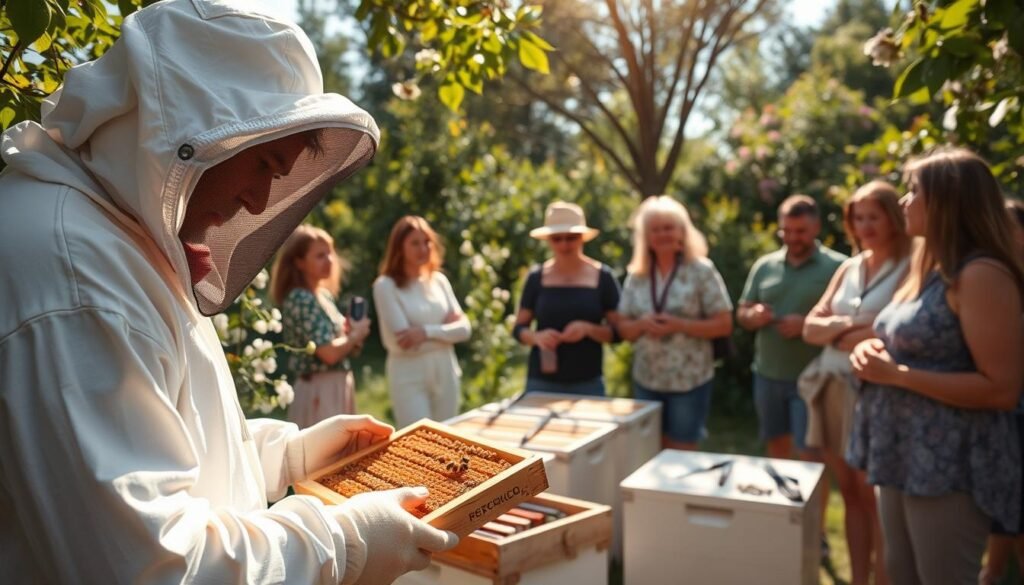
Workshops, Training Sessions and Hive Inspections
Hands-on hive inspection sessions run this June and July, led by certified apiculturists. Participants learn to:
- Assess brood patterns for colony health indicators
- Identify early signs of varroa mite infestations
- Locate queens efficiently during peak activity
Two-hour sessions cost $60+HST per adult, with minors attending free. Spaces fill quickly – registration ensures personalised guidance. “These workshops transform how newcomers approach hive checks,” says a NSW apiary inspector.
Pest management training covers both prevention and treatment. Focus areas include:
| Threat | Prevention | Treatment |
|---|---|---|
| Small Hive Beetle | Ground sanitation | Diatomaceous earth traps |
| Wax Moth | Strong colonies | Freezing combs |
| Ants | Moated stands | Cinnamon barriers |
Post-workshop support includes seasonal checklists and direct access to experts. Networking opportunities let hobbyists exchange tips with commercial operators, strengthening the entire beekeeping community.
Expert Advice and Guidance for Successful Beekeeping
Mastering apiculture demands more than quality tools – it requires wisdom forged through seasons of challenges. Our experienced team shares hard-won knowledge to help colonies thrive in Australia’s unique conditions.
Insider Tips on Hive Management
Seasonal strategies make or break apiary success. Coastal operators schedule inspections before summer storms, while inland keepers prioritise shade during heatwaves. “Preventative care beats reactive fixes every time,” notes a Murray-Darling apiarist with 22 years’ experience.
| Challenge | Prevention Strategy |
|---|---|
| Brood diseases | Monthly frame rotation |
| Honey crystallisation | Controlled storage temps |
| Queen failure | Genetic diversity plans |
Insights from Seasoned Professionals
Learn from those who’ve navigated droughts and deluges. One Western Australian keeper shares: “We now plant native shrubs as windbreaks – they feed bees and protect hives.” Such adaptive techniques form our core guidance.
Connect with our mentors through live Q&A sessions or detailed resource libraries. Whether refining harvest schedules or tackling pest outbreaks, practical solutions await. Together, we strengthen Australia’s apiary traditions through shared expertise.

